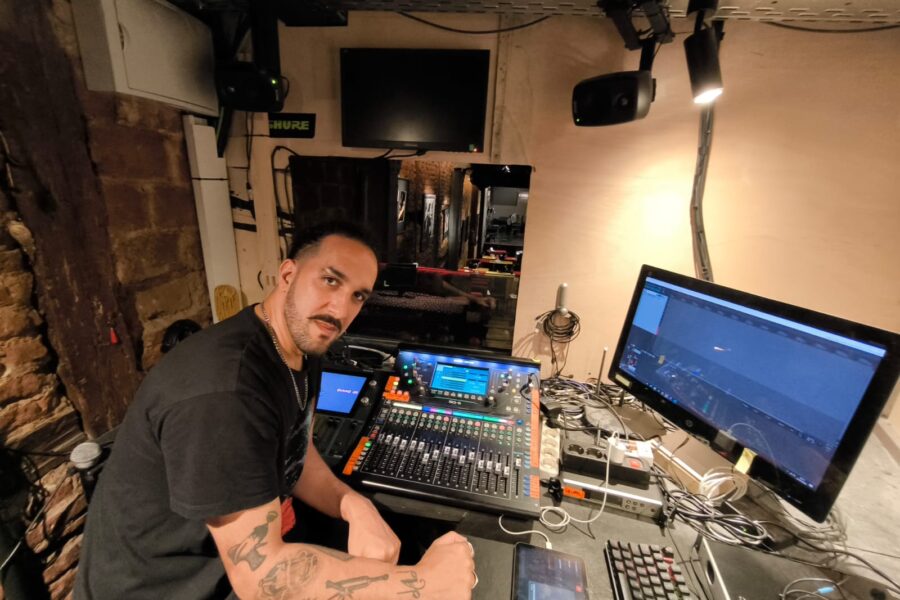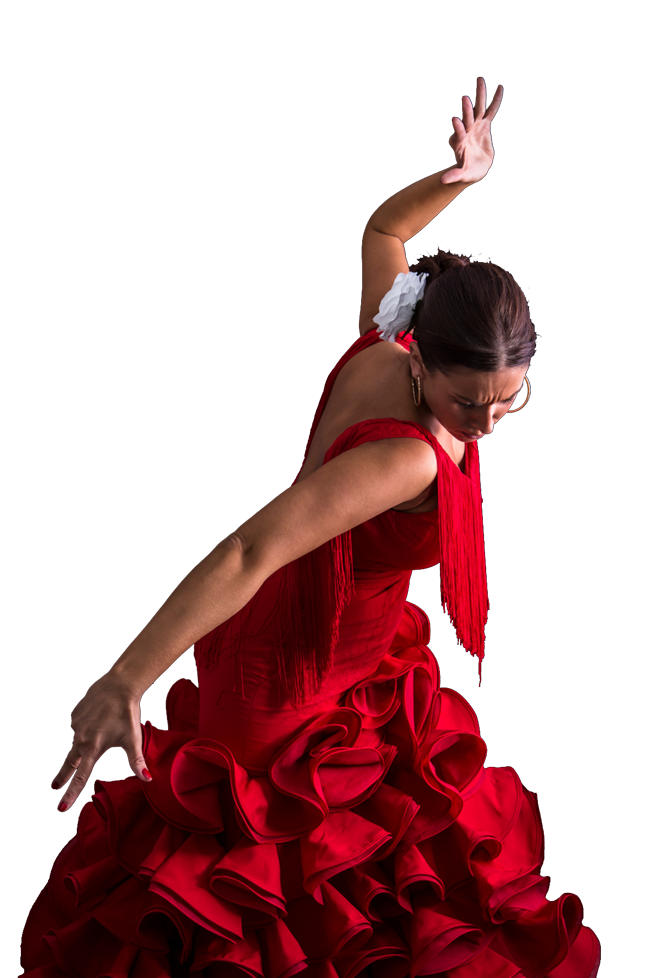In the dimness of the room, far from the spotlights that crown the artists, lies the technical booth of Cardamomo. It is a sanctuary of soft lights and silent controls, from where the emotional storm of the stage is guided.
There works Tato, the lighting and sound technician — the guardian of the tablao’s atmosphere. Today, we’re not talking to the technician, but to the artist who hides behind the mixing desk.
We sat down with Tato in the technical booth, just before the show begins. The atmosphere is calm, with the soft hum of the equipment.
Painting with Light, Feeling through the Eyes
INTERVIEWER: Let’s talk about your first canvas: light. For many, light is simply there to let us see. But in a tablao like this, it seems like its role is something else. For you, what is the true mission of light in a flamenco show? What are you trying to express with it?
TATO: “For me, the true mission of lighting is to create sensations by coloring the scene and the artist, enhancing their intentions when dancing. I try to reach the point of creating the impression of a museum painting: shadows, flashes, glow, chiaroscuro, penumbra, depth… the impression.”
INTERVIEWER: Let’s talk about a very powerful tool: the spotlight. That single light that falls from above and completely isolates the artist. In such a collective art form, when do you decide it’s the right moment to ‘switch off’ the world and leave a singer or dancer in that luminous solitude? What do you want the audience to feel?
TATO: “The overhead spotlight — the magical or secret weapon. It’s the most precise one, though it requires the artist to be well placed (laughs). I say this because in spontaneous moments it can be hard to guess where the artist will be, and that’s something to consider.
The main function for me is to illuminate the face and torso, giving a sense of levitation or ascension — as if they were a deity. Using it on its own is the most intimate point you can reach and, as a result, it focuses the audience’s attention to the maximum. Then, of course, comes the color; each frequency is a world in itself.”
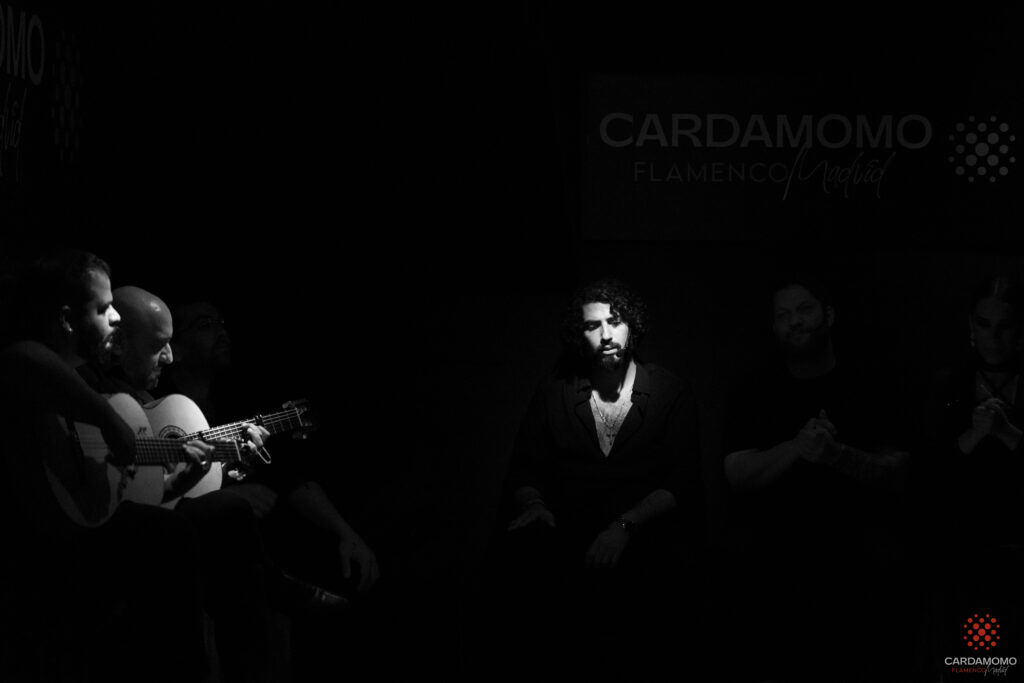
INTERVIEWER: And then there’s backlighting, which is almost a bold move in flamenco. It’s an art form that lives through facial expression, and this technique hides it completely. What power does a silhouette hold for you? At what moments in the show can a shadow tell more than a visible face?
TATO: “Backlighting is an ally for creating uncertainty, doubt, provoking fear of the unknown — the human fear of not seeing the face. But at the same time, it artistically defines the silhouette or the human body, outlining every curve. Visually, it’s special because it draws the human outline. Using it at the beginning, in a brushing step or a pause, and at the end of the dance can be very effective. It also makes possible the artistic or rhythmic progression of the dance.”
INTERVIEWER: Beyond the white of light and the darkness of shadow, there is color. Red is almost synonymous with flamenco passion. How do you decide to use color? How does your palette shift to accompany the joy of a bulería versus the solemnity of a soleá?
TATO: “Red — a classic in the genre. The styles where I use red are soleá por bulería and seguiriyas, and sometimes also soleá. It simply fits those styles. It’s something synesthetic or ineffable and, at the same time, I don’t really know why. Somehow, I think we associate that color with flamenco almost naturally or unconsciously, maybe because of the rose’s color.
For a soleá por bulería I would use red-blue or red-green, always with some progression, but seeking a strong presence of shadow and penumbra. For alegría, the opposite: violet, cyan, turquoise blue… general vibrancy and high brightness. With soleá, I also seek penumbra, but with a very warm, shadowy tone — as if lit by candles or oil lamps, simulating an old house from the early twentieth century.”

Sculpting Sound, Weaving Duende
INTERVIEWER: If light guides the eyes, sound goes straight to the heart. Onstage there is singing, guitar, palmas, cajón, footwork… a sound universe that could become chaotic. What’s your philosophy to make sure it’s not noise, but a perfectly balanced conversation?
TATO: “The first thing is to have good musicians who can understand each other (laughs). You can’t get good sound without synergy and mutual emphasis. From there, you need good acoustics, then good sound gear, and finally a well-balanced audio mix. Of course, this is not something you can do without understanding the genre—in this case, flamenco. I doubt it can be done with mathematical precision. We aim to enhance the music of the ensemble with sound, sometimes exploring creative ground like changes in reverb or delay. The balance lies in having technical control—starting with the stage and then the P.A. system—along with creativity in tone, dynamics, stereo image, and effects.”
INTERVIEWER: You’ve told us a secret: the floor at Cardamomo is mic’d. That kind of obsession with detail is impressive. Why the need to capture the sound of the wood? What are you trying to make us feel with the zapateado, beyond just rhythm?
TATO: “The architectural acoustics we’d need if we didn’t mic the floor would be like building the pyramids (laughs). What I mean is, when you perform for an audience, the first thing you need is for the floor to be built like an instrument that resonates naturally. Then, we mic that instrument. What I aim for when detailing sound is to simulate what a dancer feels when doing footwork, even using techniques that let us perceive tiny micro-details when listening. That way, you feel it closer.”
INTERVIEWER: They say a good sound technician sculpts tone like a sculptor with their chisel. Can you give us a practical example? What do you “cut” or “boost” in the sound of a soft guitar passage, or what do you “highlight” or “deepen” in the broken voice of a singer in a seguiriya?
TATO: “The equalizer is our tool for increasing or reducing the frequencies of each instrument. We could talk about tonal saturation, but that wouldn’t make sense here (laughs). Within the basic quality of live music, we understand that sound can be shaped as if it were a piece of clay. For example, each guitar, voice, artist, venue, sound system—every day is different… The challenge in live sound is knowing what to do at every moment. In general, the first thing we do is fix any audio issues that might arise, and then we try to translate the artist’s tone and qualities in the clearest way possible.”
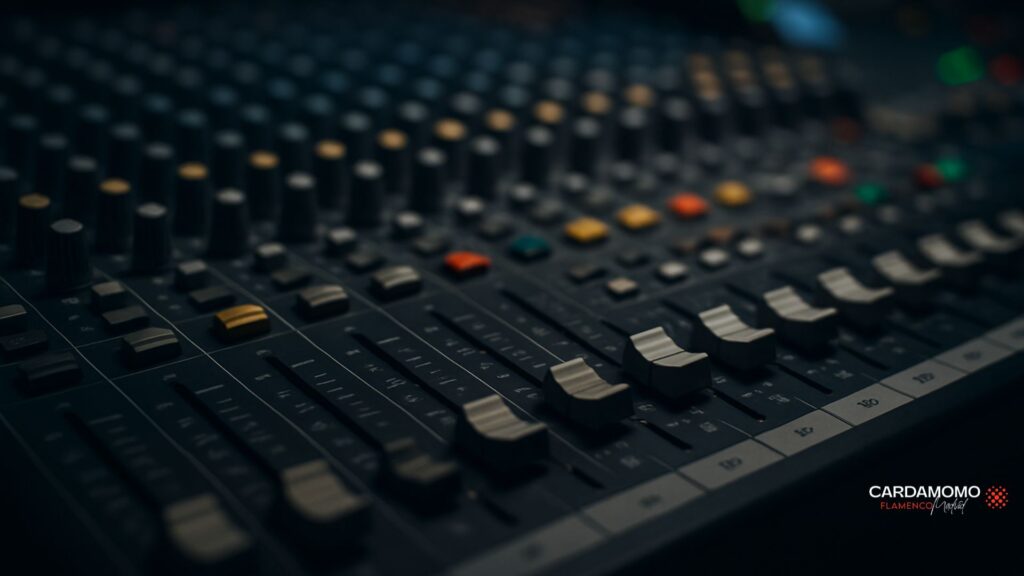
The Musician in the Shadows
INTERVIEWER: All of this comes to life onstage, where nothing is written. Flamenco is pure improvisation. A singer breaks, a dancer launches into unexpected footwork… You can’t follow a script. How do you experience that tension from the booth? Do you feel like another artist, improvising with them in real time?
TATO: “The tension created by that artistic uncertainty is what keeps you alert, and that adrenaline is what makes it fun. I’m not saying the stress it brings is always pleasant (laughs), but being present makes it special and enjoyable.
Of course, I feel like another artist, even though in general our work is neither recognized nor appreciated by default. Mixing sound is a very complex art; I always say that sound can’t be seen with the eyes — that’s why it’s so abstract. Every time I operate flamenco, I feel responsible for translating emotions into sound, the lines, and the unity among the musicians. You need a form of synesthesia to achieve that. For example, the movement of a dancer or the emotion born at a certain moment in the show can determine how much reverb a voice needs, or how soft or aggressive a given element should be. I believe all these decisions are based either on logic or instinct, depending on how well you understand the genre, the artist, and the moment.”
INTERVIEWER: And that connection with the artists — how is it built? Is there a plan before each night, are there shared looks during the show, or is it pure intuition developed over many nights of duende?
TATO: “It’s built by being clear that duende exists and that it connects us — that’s essential. However, there also has to be personal experience, training, a background, a style… But in live performance, anything that isn’t already prepared is ruled by the connection between the mixer and the musician. Just through glances, there’s already a language — that’s why people say ‘you mix with your eyes’. But all of that is only achieved through developing skills, and that’s done by doing, and doing live shows.”
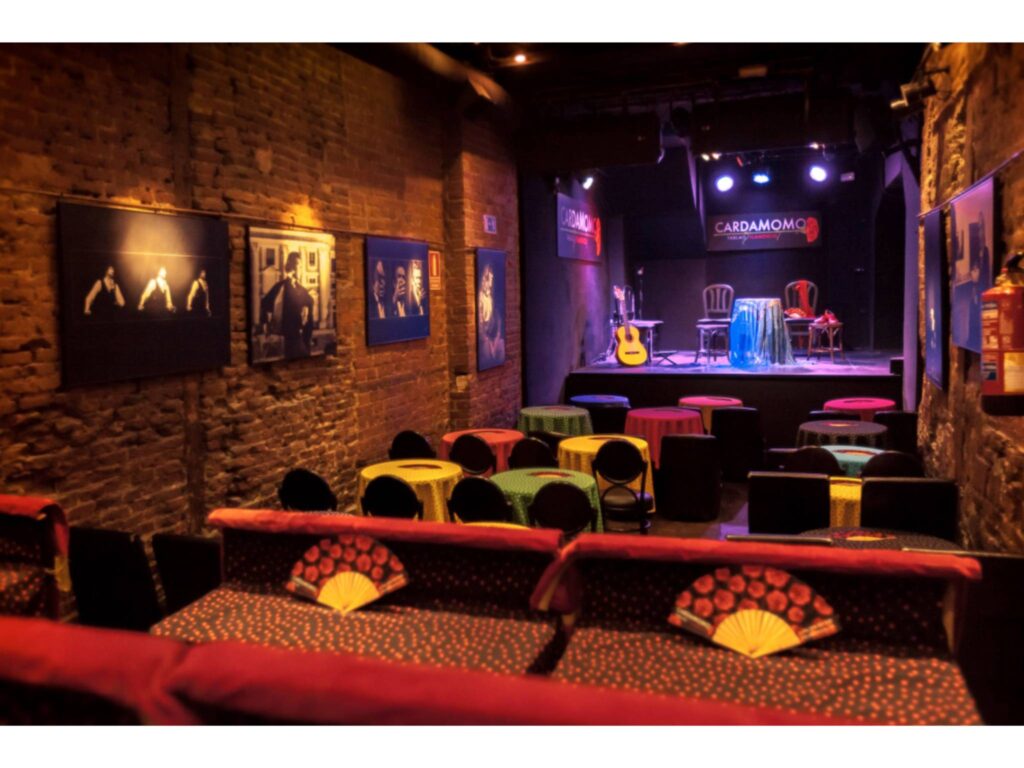
Finale: The Magic Revealed
INTERVIEWER: At the end of the night, when the audience erupts in applause for the artists on stage, what tells you that “tonight, the job is done”? What’s your silent applause?
TATO: “In general, when the audience cheers at the end or even after a final note, that confirms that the show — or the action — has reached them. And that already tells us that it worked and that our purpose in this type of business, where the client has to leave satisfied, is fulfilled.
But here’s another angle: that of artistic or disciplinary level. I suppose that, as artists working with music and dance, the more time passes, the more we want to be better at our craft. What I mean is that, if someone comes to see the show and doesn’t have much background, can we say it’s easier to impress them because art is so subjective? What moves one person might not move another. So yes, the show probably always works, but… can we really rely on audience reaction to know if it was truly art? Or should we listen to and trust our own impression to understand how meaningful it was?”
INTERVIEWER: To close, Tato. Imagine you could whisper something into the ear of each person who walks through the doors of Cardamomo — something that opens not just their eyes and ears, but also their soul to your invisible work. What would you say?
TATO: “Well, without joking, I’d tell them: while the show is happening, don’t talk to your friends. Put away your phones so you can watch the show with your eyes — that’s how you’ll understand the flow and the full picture of the dances. And applaud if you feel moved to… (laughs).”
(The interviewer thanks Tato. The conversation ends just as the first guitar chords begin to play for soundcheck, and Tato’s booth comes back to life.)
You now know Cardamomo’s best-kept secret: the invisible artist named Tato. His light doesn’t just illuminate — it tells stories. His sound doesn’t amplify — it weaves emotion.
Don’t just come to watch flamenco. Come to feel it like never before.
The magic awaits. The stage is ready. And so is the booth.


